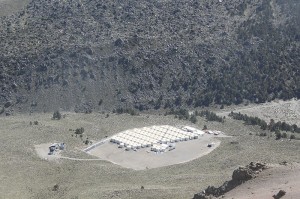
I am working with Dr. Petra Huentemeyer on the HAWC (short for High Altitude Water Cherenkov) experiment, a very high energy (VHE) gamma-ray observatory currently being built in Mexico. In contrast to optical or radio waves, gamma-ray photons cannot penetrate the Earth’s atmosphere. Instead they collide with particles in the atmosphere and create showers of secondary particles through electromagnetic and hadronic interactions. Once completed the HAWC experiment will consist of 300 water Cherenkov detectors (WCDs), that will measure these secondary particles as they sweep through the array. The directions of the primary gamma-ray photons are reconstructed using the time between the signals in each WCD. Thus timing calibration, which is what I am currently working on, is crucial for good angular resolution. As of now, more than one third of the array is finished and operational. At the moment, I am doing a preliminary analysis of data collected with this sub-array. Figure 1 shows a picture of HAWC on July 26, 2013. My research is focusing on pulsar wind nebulae (PWNe), the largest class of galactic VHE gamma-ray sources. PWNe produce electromagnetic radiation in a very broad energy range from radio to VHE gamma rays, and thereby provide an excellent laboratory to study the physical processes at very high energy. Figure 2 shows the crab nebula at different wavelengths. Using data collected with the complete HAWC array, I will reconstruct the energy spectrum of gamma rays emitted by PWNe. I will combine my analysis results with data from other experiments that take measurements at lower energies, to reveal the physics processes occurring in PWNe.
by Hao Zhou
